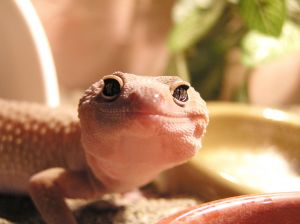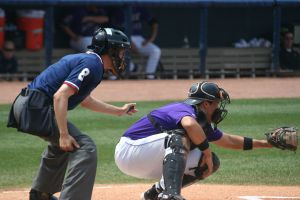Caring for geckos is a skill that can be learned quickly at a basic level, but can deepen over the course of years as the keeper learns more about a species in general and his or her own geckos in particular. Along the way, there are a lot of questions about geckos’ basic behavior: eating too much or too little, overly active or worryingly lethargic, cuts, scrapes, bumps on the body to mention a few of the issues that arise frequently. As part of an ongoing attempt to provide information about gecko care that’s conceptual as well as factual, I want to stress the importance of context in analyzing a gecko’s behavior. In order to know whether a gecko is behaving appropriately, it’s important to know how its needs are or aren’t being met, and, in the case of this article, where the gecko is in its yearly cycle of behavior. What follows is a “trip” through a year with my eublepharid (eyelid) geckos: primarily leopard geckos, but African fat tails and banded geckos (Coleonyx) as well. The information is accurate, but is a composite of my seven seasons of experience breeding and represents an average year in the hobby; the specific anecdotes are all true and accurate.
[ad#sponsor]
Winter
January
The date I’ve been awaiting eagerly for the past few months has finally arrived: January 15, the day I re-unite my male leopard geckos with their harems for the season. Within minutes, one of the three males is rattling his tail and starting his mating dance. He is not well received: the females aren’t ovulating yet. A perfect gentleman, he backs off for the evening. The fat tails and banded geckos don’t get this reunion as they’re kept together all year. Normally I would be turning the temperature up in their cages, but this year, after experiencing an unexpected Coleonyx death in the early stages of cooling, I’ve decided not to cool. Despite these early signs of the beginning of the breeding season, it is still deep winter here in New England. It’s snowing every week and the ambient temperature in my living room is in the mid-60’s. Only about a quarter of my 16 leopard geckos are eating, mostly the juveniles left over from last season, and no one is eating much, even though I’m only offering food every 3 days. A few of the females have curled up on the cool side of the enclosure and are sleeping around the clock. Oskar, my super snow male, hasn’t eaten since mid-November. His nostrils are plugged again, as they are every year, he’s breathing through his mouth and will take a trip tomorrow to the vet to get treatment for his annual respiratory infection.
February
The first leopard gecko and fat tail eggs are laid by the early ovulators at the beginning of February. I’ve had the incubator up and running since early January and am eager to get started with the season. By the middle of the month I have 10 eggs in the incubator and within a week 8 of them are collapsed and molding. The geckos, even those who have laid, are still not really eating. Oskar is nearly at the end of his antibiotic treatment and, while he may be drinking water, the drugs are about the only other thing he’s ingesting. I’ve been able to get him to eat 1 mealworm all month. I was able to get one nostril unplugged by softening it up with bacitracin so he’s a bit more comfortable.
March
I now have had 16 eggs that have been laid and only 2 good ones in the incubator. My raptor has laid 2 clutches in her hide despite my putting her in the lay box at least 10 times a day. Three quarters of the geckos are ovulating and the sound of rattling tails is heard throughout the living room every evening. Most of the males are successful in their mating attempts, even the shy fat tail males who make a tentative move and back off. They must be having some success since I’ve already gotten 2 fat tail clutches, including the only pair of eggs that hasn’t collapsed. Most of the geckos are hardly eating. Oskar continues to lose weight slowly and is having trouble shedding – the forced hot air heating dries everything out in the winter despite his having a humid hide. My mealworms are all turning into aliens, my hatch rate is in the cellar, no one is eating and I’m wondering if I’m going to have any kind of season at all, not to mention if my fasting geckos are healthy. The only thing that keeps me going: it was the same last year at this time.
Spring
April
The trees are budding and we’re on daylight savings time. I have 10 eggs in the incubator with all 3 species represented. Two of the females that have laid several clutches pace the cage in the evenings, their heads in striking position whenever they see me handling a superworm. A few of the males are now taking an occasional feeder. One of the female fat tails stopped eating for a week. I picked her up and shoved a couple of crickets in her mouth and she switched on again. The fat tails have a nightly routine on feeding days, which is still every 3rd day: after eating their dusted crickets on the heated side of the cage, they climb over the plexiglass divider to the planted part of the cage, have a drink from the ceramic water bowl and stretch out under the haworthia plants. It’s nice to see them using the entire tank. One of the 2 fat tail eggs hatched the last week in the month and the baby is in residence in my rack eating small crickets. Oskar continues to refuse food.
May
I’m not foolish enough to expect warm weather this month. It hovers around 60 degrees most days and rains 3 out of 4 days. Baseball games are being postponed which means I have nothing to listen to during my feeding routines. I can now predict which gecko will lay next, not only by the size of the eggs when I look in the belly, but by the way the geckos getting ready to lay act restless and move around even during the daytime. Every breeding female has laid at least 1 clutch and all but 2 are eating regularly. I am now feeding the adults every other day and the babies every day. It seems that everyone wants to lay eggs on Tuesdays and Thursdays. My first leopard gecko eggs hatched in the middle of the month and the babies are thriving, pooping 3-4 times a day. My best way of knowing it’s mid-spring –Oskar is eating! Two superworms one day and a few crickets 3 days later.
June
All systems are go! (and the Red Sox are in first place). Everyone is eating, all the females are ovulating, and tails are rattling all over the place. The incubator is nearly full with some of the geckos on their sixth or seventh clutch. My leopard gecko hatch rate is rapidly approaching its usual 85% rate with the fat tails at their usual 50% rate. The Coleonyx are a crapshoot since it’s hard to find their eggs in time. I can now predict how many babies I’ll be taking to my first reptile show of the season at the end of August. One of the females has a gash in her tail from an overenthusiastic male. I separated her for a week until the gash closed and, since the male is rarely routinely that aggressive, have returned her to her usual enclosure with him. Everything is going fine with them. Oskar has gained 5 grams and is eating regularly.
Summer
July
The ambient temperature in my non-air conditioned living room frequently reaches 89 degrees (the crestie and gargoyle geckos are in their basement condos during the days so they can keep cool). Many of the geckos are hanging out on the cool side. My glass hatchling enclosures are full and the “overflow” rack is filling up. All the adults are eating well, some independently and some with assistance. My enigma, Yahli, as always, gets put into the humid hide with her crickets so she can catch them in a more limited space since she’s clumsy at hunting as well as at everything else. It doesn’t keep her from climbing to the top of the magnet hides, though. Nearly all the babies are eating well. I have a couple who can’t figure out the mealworm bowl, though, and some who think my fingers are giant mealworms and latch on every time I put my hand in their enclosures. A combination of hand-feeding and switching to crickets and superworms is helping nearly everyone. One baby just isn’t eating no matter what I do and isn’t really growing. There may be hope for her, but there’s a good chance she won’t make it. The fat tails have finished laying for the season and the last of their eggs has hatched. Oskar is up to 85 grams.
August
I’m getting a little worried: the overflow hatchling rack is nearly full. It’s going to be a close thing between the hatching dates and my first show. I don’t know what I’m going to do if more than 6 geckos hatch before the show; I don’t know where I’m going to put them. Even though my mealworm colony is doing well, I had to buy 10,000 mealworms at the beginning of the month to feed the babies, and they’re almost gone. The sound of rattling tails has pretty much stopped. The males are done and now ignore their female cagemates. That’s a relief. With hatchlings it can be too much of a good thing. The “failure to thrive” baby died at the beginning of the month. Most of the slow learners have figured it out by now. Two are still gaining very slowly –at 8 weeks they weigh only 5 grams, but they are eating, look well-proportioned and will eventually catch up. The Coleonyx continue to lay clutch after clutch, but most of the latest clutches are infertile. The first show, at the end of the month, was successful. The best part is coming back and figuring out which hatchlings will get the “upgrade” from the 6 quart rack tubs to 1/3 of a 20 gallon long glass enclosure. Priority goes to the biggest ones and the best eaters.
September
My last leopard gecko egg of the season was laid the first week in September. The fat tails are long done, and the Coleonyx will continue forever but nothing will be viable. The geckos have spent the first part of September eating themselves silly. All the male leos, including Oskar, are above 95 grams, with my albino “stud”, Eragon, up to 116. Copper, the male fat tail, is at 82 grams. The females have mostly recovered their pre-breeding weights and the leopard gecko females all weigh between 55 and 85 grams. The last week in September there is a brief cold spell and even though the temperature in the living room remains about the same, there is a dramatic decrease in eating among nearly all the adult geckos. Feeding goes back to every 3rd day for the adults and remains daily for the babies.
Fall
October
By the end of the month I’ve attended 3 shows and have “only” 20 more leopard geckos to sell. The fat tails have all been sold locally and the Coleonyx were shipped to various locations around the country. I’m starting to think about how to group the leopard geckos for next season’s breeding. I’ll be removing the males each to his own enclosure as soon as I sell enough babies to free up the cages. Sometimes this happens in October, but lately it’s taken till November or even December.
November
The last leopard gecko eggs hatch the second week of the month. I’ve sold another 5 geckos and am making plans to attend a larger show 4 hours away to try to move at least 10 more. By Thanksgiving all the males have been removed to their own enclosures. The heat in the house is coming on most evenings, but temperatures during the day are in the low to mid 60’s. Except for 3 geckos, most of the leos are barely eating. The fat tails and the Coleonyx continue as usual, but I’m slowly lowering the temperatures this month because I’m planning to cool them from December first till mid-January. Oskar has stopped eating.
December
We’ve had the first snowfall, though it didn’t last. The geckos are lethargic and some have retreated to the cool side of the hide. They are barely eating and even the “babies” (some of whom are approaching 50 grams) aren’t that hungry. Even so, no one has noticeably lost weight. The fat tails and Coleonyx are sleeping away in their cooled enclosures, though I worry that the cages are too near the heat vent and that they won’t be cold enough. At any rate, I’m not feeding them. The female leopard geckos have been reconfigured in their groups for the coming season. I’m counting the days till January 15, when I re-introduce the males, but glad to have a break from their breeding.
Oskar’s nostrils are plugged.
[ad#300]





Wow, this article really sparked my day. Not only show how knowing your animals is a beautiful journey on its own, but how keeping calm is always important.
Thanks so much for writting it!
A really interesting a life in the year of geckos article Aliza.
I was wondering are the geckos noisy and vocal in their breading season?
The only noise that’s heard during breeding season is the tail-rattling of the males.